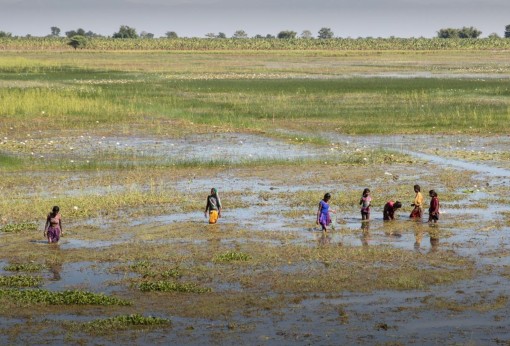Exploring the Intersections of Migration, Climate Justice, and Gender
By Ashley Moore, UCSF
2022 - 2023 Student Ambassador Cohort - Center for Gender and Health Justice
June 2, 2023
The global climate crisis is one of the greatest threats currently confronting humanity. Indeed, the now unfolding consequences of the crisis threaten virtually every major sphere of human existence, including ecological sustainability, economic security, political stability, human rights, and health equity. As the effects of the global crisis worsen, vulnerable populations around the world are disproportionately affected, and the mass displacements of refugees internationally can be largely attributed to the impacts of the climate crisis.1 Furthermore, women are disparately vulnerable to the detrimental consequences of the crisis because of the gender-related socioeconomic discrimination to which women are subject.2
Much research has been conducted on refugee and migrant health, particularly the mental health impacts of the migration process. However, scant research has examined health disparities in populations who are forced into displacement because of environmental factors. Although research on climate change is nascent, evidence to date substantiates the conclusion that the impacts of climate change on global health outcomes are severe, and these detrimental impacts are disproportionately greater in low-income countries.3

Several aspects of environmental health result in the forced migration of vulnerable populations around the world.1 Furthermore, these disparities are not the same across genders. One of the most visible impacts of climate change is the increase in severe global weather patterns—another driving factors of forced displacement. Increasing global temperatures and other environmental changes have resulted in intense weather patterns that have in turn led to increases in forest fires, tropical storms, coastal flooding, droughts, and heat waves.4 Approximately 90% of deaths caused by natural disasters occur in low-come countries that often lack the health care resources, economic infrastructures, and mitigation plans for responding to such events.5 Minority groups and low-income countries are often disproportionately hurt by the way aid is distributed in the aftermath of natural disasters. In contrast, following natural disasters, counties whose populations are predominantly White typically have higher levels of community reinvestment. These discriminatory trends manifest globally.6 Further research on this topic is vital for the development of health policy and global climate change mitigation plans.
References
- Chavers, M., Tekola, S., Winston, C., Mikhiela, S., & Shange, R. (2021). The intersectionality of Racism, globalization, climate change, and forced migration. Professional Agricultural Workers, 8(1). https://tuspubs.tuskegee.edu/cgi/viewcontent.cgi?article=1181&context=pawj
- Sam, I.S. (2019). Impacts of Climate Change Induced Migration on Gender: A qualitative study from the southwest coastal region of bangladesh. International Journal of Social Science Studies, 7(4), 57-68. https://doi.org/10.11114/ijsss.v7i4.4292
- The World Bank. (2021). High and dry: Climate change, water, and the economy.
- Desai, B., & Mandal, M. (2021). Role of climate change in exacerbating sexual and gender-based violence against women. A new challenge of international law. Environmental Policy and Law, 51(1), 137-157. https://doi.org/10.3233/EPL-210055
- Patnaik, A., Son, Jiahn, s., Feng, A., & Ade, C. (August 20, 2020). “Racial disparities and climate change.” Princeton Student Climate Initiative. https://psci.princeton.edu/tips/2020/8/15/racial-disparities-and-climate-change
- United Nations Development Program. (2021). Why Climate Change fuels violence against women. https://www.undp.org/blog/why-climate-change-fuels-violence-against-women
